宝马精益生产(BMW_VPS)培训中文版
- 格式:pdf
- 大小:6.78 MB
- 文档页数:91

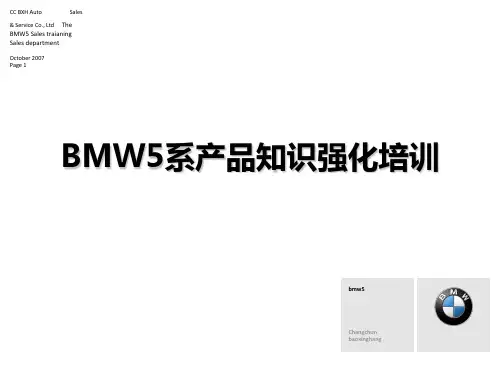

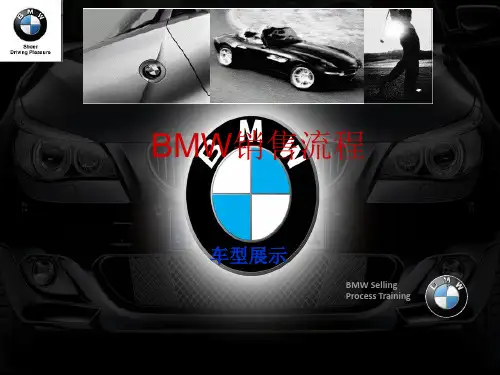


The All-New BMW 5 Series Sedan Product Launch Training 2017INDEXUNDERSTANDING. >Background >Concept1CREATIVE SOLUTION. >Storyline>Space Design2The All-New BMW 5 Series Sedan Product Launch Training 20171The All-New BMW 5 Series Sedan Product Launch Training 2017>Background >ConceptUNDERSTANDING.Time:Mid-May to Early JuneVenue:Hangzhou / Shenyang / DalianParticipant:1500 pax (Dealerships, Marketing Managers), 80 pax/ day⾸首款搭载“BMW互联驾驶”的⻋车型新BMW 5系插电式混合动⼒力轿⻋车⾸首款引⼊入基于互联⺴⽹网和移动通信最先进⾼高科技技术⻋车型BMW 5系混合动⼒力⻋车型全球亮相“宝⻢马专属定制”2013年推出,2014年服务范围进⼀一步开放2011 2012 20132014 2015 2016不断进取的时代领军操控:回归动感智能的驾控体验,有史以来最⼤大提升。
设计:更宽敞精致内部空间享受。
外观,极具流线美学。
与世界随时随地⽆无缝衔接。
最具进取精神的商务座驾哥伦布,开辟新航路,刷新地理认知界限。
⻉贝尔发明电话,开启⼈人类沟通新纪元。
凯⽂文斯特罗姆创建Instagram ,提供⽣生活分享新⽅方式。
进取者群像历史的先⾏行者 时代的先锋Concept InspirationUNDERSTANDING.1新5系受众-进取者宽阔胸怀不违初⼼心良好修养格调优雅Concept InspirationUNDERSTANDING.1全新5系舒适互联操控外观初⼼心品味个性胸怀对应受众训练四种素质培训进取精神进取者训练营Follow the AspirantTD Space DesignCREATIVE SOLUTION.21. 试驾⻋车辆摆放⽅方式2. ⻛风景试驾培训篷房3. 场地试驾培训篷房1 2 32The All-New BMW 5 Series Sedan Product Launch Training 2017>Storyline>Space DesignCREATIVE SOLUTION.这是⼀一次进取者的⾃自我升级之旅。
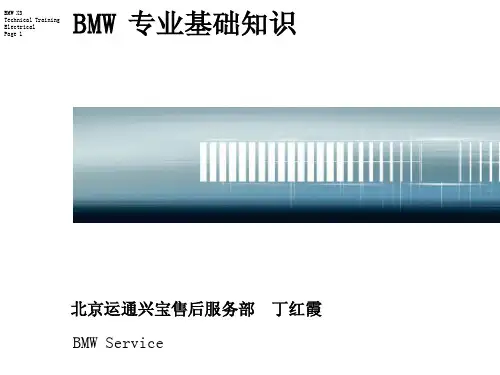
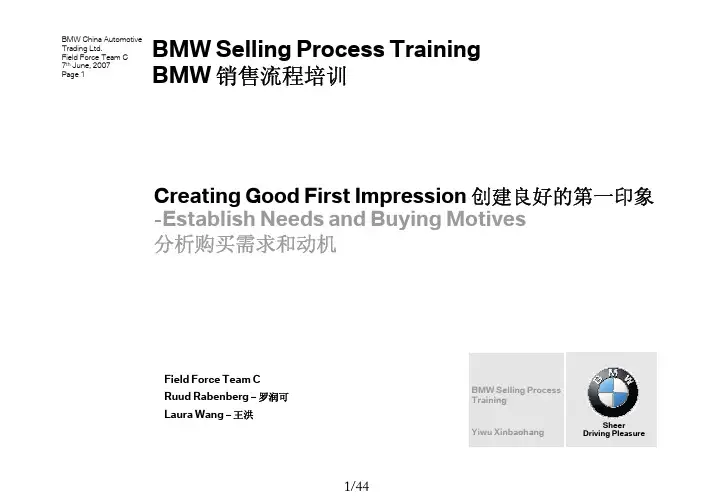
BMW China Automotive Trading Ltd. Field Force Team C 7th June, 2007 Page 1BMW Selling Process Training BMW 销售流程培训Creating Good First Impression 创建良好的第一印象 -Establish Needs and Buying Motives 分析购买需求和动机Field Force Team C Ruud Rabenberg – 罗润可 Laura Wang – 王洪Yiwu XinbaohangSheer Driving PleasureBMW Selling Process Training1/44BMW China Automotive Trading Ltd. Field Force Team C 7th June, 2007 Page 2Create Good First Impression创建良好的第一印象 Establish Needs and Buying Motives分析购买需求和动机Training Agenda 议程安排 17:50 – 18:50 Review of the whole BMW Selling Process and discussion on Establish Needs and Buying Motives including some activities. 回顾BMW的完整销售流程, 着重培训流程中分析购买需求和动机 环节包括小组讨论. 18:50 - 19:20 Listening Audit for Needs Analysis. 需求分析中的倾听技巧. 19:20 – 19:40 Movie Watching. 案例短片观看. 19:40 – 20:00 Roll Play and Finish of the Training. 角色扮演, 结束培训.2/44BMW China Automotive Trading Ltd. Field Force Team C 7th June, 2007 Page 3任务12,再次购买 1,系统的潜在客 户开发11,保证持续的客 户关怀2,欢迎/建立联系/ 关系要求关怀和准备 询问和分析10,新车交付维户 客 护 度忠诚创建 良 一 好 印 的 象 第3,建立购买需求 和动机获得 购 买原则承 诺产 生买 购愿望4,演示/介绍产品9,达成销售坚持和销售 演示和咨询5,推销产品卖点 8,销售谈判7,清除客户异议6,进行试驾3/44BMW China Automotive Trading Ltd. Field Force Team C 7th June, 2007 Page 4Create Good First Impression创建良好的第一印象 Establish Needs and Buying Motives分析购买需求和动机Training Targets 培训目标.What do you expect to know/learn from the training ? 你对此次培训的期望是什么 ?4/44BMW China Automotive Trading Ltd. Field Force Team C 7th June, 2007 Page 5Create Good First Impression创建良好的第一印象 Establish Needs and Buying Motives分析购买需求和动机Group Activity 分组讨论: -Please divide by 2 groups. 分成两组讨论. - 10 minutes discussion 时间要求:10分钟 - Each group think about minimum 5 questions, which you frequently ask during your conversation to customers, and why you ask these questions? 每个小组 讨论在你与客户进行需求分析交谈中至少5个会经常问到的 问题,以及你为什么会对这些信息感兴趣? - On person to present on behalf of the group. 请小组代 表发言.5/44BMW China Automotive Trading Ltd. Field Force Team C 7th June, 2007 Page 6Create Good First Impression创建良好的第一印象 Establish Needs and Buying Motives分析购买需求和动机6/44BMW China Automotive Trading Ltd. Field Force Team C 7th June, 2007 Page 7Create Good First Impression创建良好的第一印象 Establish Needs and Buying Motives分析购买需求和动机Small check if you really do as you present in your work ☺. 检测一下, 你们在实际工作中的表现吧!☺Showroom Prospects Pictures.展厅潜在客户照. Pictures were taken on 7th June .7/44BMW China Automotive Trading Ltd. Field Force Team C 7th June, 2007 Page 8Create Good First Impression创建良好的第一印象 Establish Needs and Buying Motives分析购买需求和动机SC 销售顾问: ??? How much do you know about this prospect? 你对 这位潜在客户了解多少?8/44BMW China Automotive Trading Ltd. Field Force Team C 7th June, 2007 Page 9Create Good First Impression创建良好的第一印象 Establish Needs and Buying Motives分析购买需求和动机SC 销售顾问: ??? How much do you know about this prospect? 你对 这位潜在客户了解多少?9/44BMW China Automotive Trading Ltd. Field Force Team C 7th June, 2007 Page 10Create Good First Impression创建良好的第一印象 Establish Needs and Buying Motives分析购买需求和动机SC 销售顾问: ??? How much do you know about this prospect? 你对这位潜在客户了解 多少?10/447th June,2007Page 11Establish Needs and Buying Motives分析购买需求和动机Objective and Purpose For Needs Analysis需求分析的目的.•Determining customer needs.认知客户的需求.•Creation of a trusting customer relationship.建立信任关系.•Collection of information to create an tailored offer to thecustomer.收集信息进行针对性的有效销售.7th June,2007Page 12 Useful Information For Needs Analysis 需求分析中的重要信息Purchase Budget 购买预算Usage of the Vehicle (Business/Private)车子用途(商用/个人)Current Vehicle 先有车型Number of Kilometers 行驶里程数Personal preferences (Luxury/Comfort/Sporty)个人偏好(豪华/舒适/运动性能)Number of Families 家庭成员Interested Model 感兴趣车型Etc………等等……Establish Needs and Buying Motives分析购买需求和动机As open questions to get the information.提问开放性问题Why 为什么……? How 如何……?What 什么……? Who 谁……?When 何时……?7th June,2007Page 13Establish Needs and Buying Motives分析购买需求和动机Questionnaire about Listening Audit 倾听方法调查问卷-Everyone will get a questionnaire about listening audit. 每位销售顾问都会拿到一份问卷.-You will have 10 minutes to answer all the questions.请在十分钟内回答所有的问题.-The purpose of this test is to help yourself to clearly seehow do you normally make listening audit during yourcommunication with your customers. 此问卷的目的是要真实反映你与客户交谈中通常所采取的倾听方法.7th June,2007Page 161.I make it a point to address each customer by name.我觉得称呼客人姓名很重要(Always 一贯如此)Establish Needs and Buying Motives分析购买需求和动机If you do this always, or at least frequently, then good for you! It means thatyou’re making an effort to focus your attention on your customers and let themknow you’re interested in them.如果你一贯如此,或者至少经常这么做,恭喜你,这表明你在努力集中精力与客人的谈话,并且让客人知道你对他们很感兴趣.2.I finish sentences for customers in an effort to helpthem express themselves more clearly.(Never –从不)为了帮助客人表达自己更清晰,我会结束他们的谈话Although you might think you’re helping your customers, finishing sentences for them is apt to do more harm than good. As a salesperson, you’ve learned to be comfortable talking to people and expressing yourself verbally. Most people have a harder timewith that. While it may take them a bit longer to express themselves, you’ll build better rapport and gather more accurate information by letting them have their say .虽然你可能认为结束客人的谈话,是好意在帮助他们.但是打断客户的谈话弊大于利.千万不要因为客人表达能力差,销售员打断并帮他说出他自己的需求,其实没有任何人知道客人的需求,除了他自己.所以给客人时间, 让他说出它真正的需求7th June,2007Page 17 3.When listening to a customer, I mentally take note of keypoints. (Always –一贯如此)当我倾听客人讲话时, 我会记录下客人所说的要点在头脑中Establish Needs and Buying Motives分析购买需求和动机If you’re a salesperson, you’re probably a “people”person and you undoubtedly have some very good instincts, but you can never know exactly what customers need without asking them and taking the time to listen to their answers如果你是一个专业的销售顾问,你肯定有一些直觉, 但是不通过提问和倾听客人的反馈,你就不可能确切的知道客人真正的需求是什么.4.I am so attuned to my customers that I find I can anticipatetheir needs without much preliminary discussion. 我非常熟悉我的客户,以至于我发现不用太多地与客户周旋(需求分析)我就能够预料到他们的需求(Never –从不)This is a good way to keep your attention focused on the conversation, and it’sabsolutely necessary if you want to recommend the right vehicle for yourcustomer.这是一个帮助你集中注意力在与客人的谈话上的好方法, 并且如果你想为客人介绍他真正需求的车型这是完全必需的.7th June,2007Page 18 5.When appropriate, I paraphrase the customer’s significantstatements (Always –一贯如此)适当的时候, 我会释义客人的重点表述Establish Needs and Buying Motives分析购买需求和动机Paraphrasing accomplishes two things:it lets the customer know you were paying attention, and it helps you check your understanding of the conversation for accuracy.释义帮助我们完成两件事:让客人知道你在注意他的谈话,同时可以帮助你检查对谈话理解的准确性6.While listening to customers I pay attention only to what’sbeing said. I try not to be influenced by facial expression,body language, etc.我主要精力用在倾听客人正在说的,试着不被客人的面部表情和肢体语言所影响(Never –从不)While words are important, body language, facial expression, tone of voice, etc.contribute to our overall understanding of what’s being said and are critical toaccurate interpretation of the customer’s needs .当然客户所说的话是重要的,但是客户的肢体语言,面部表情,语调对我们正确理解客户的谈话是同样不容忽视的,并且对我们精确对客户需求的理解也是至关重要的.7th June,2007Page 197.During the conversation, I ask questions to make sure Iclearly understand what the customer has said. 交谈中,我用问题确认我是否清楚客人所说的内容(Always –一贯如此)Establish Needs and Buying Motives分析购买需求和动机Questions are the best way to gather information and clarify any points aboutwhich there might be some confusion. Questions are an important part of thelistening process..提问是获取客户信息和澄清任何迷惑的最好的途径. 提问是倾听过程中重要的一部分.8.While listening to customers I work on my sales strategy,carefully planning what I’ll say next. (Never –从不)当我听客人讲话时, 我运用销售策略仔细的计划下一步要说的话If you’re planning what you’re going to say, your mind has wandered away from the conversation and you are no longer listening. Focusing means paying attention to what’s being said now, not what you’re going to say.在与客户交谈时,如果你总是计划下一步要说什么,那么你的注意力也就不在谈话上了,你也就不再听客人说什么了.集中注意力指的是注意客人正在说的而不是你接下来要说什么.7th June,2007Page 209.At the end of my initial conversation with a customer, Isummarize aloud what I’ve learned about his/her needsand concerns. (Always –一贯如此)每次与客户谈话即将结束时,我都会总结并与客户确认我所听到的客人的需求信息.Establish Needs and Buying Motives分析购买需求和动机A summary tells the customer what you’ve learned about his/her needs from the conversation and gives him/her a chance to correct any understanding.总结可以告诉客户从你们的交谈中你得到的信息的准确性, 并且给他们机会去更正其中的误解.10.Before suggesting a vehicle, I ask if the customer has anyother requirements. (Always –一贯如此)在为客人介绍一款车型之前,我会询问客人是否还有其他需求Give the customer the opportunity to tell you anything else that is pertinent to his/her vehicle selection in case something important was forgotten.为了防止重要的信息被漏掉, 给客人机会,引导他,让他告诉你一切与他选择车型有关的事情.BMW China Automotive Trading Ltd. Field Force Team C 7th June, 2007 Page 21Create Good First Impression创建良好的第一印象 Establish Needs and Buying Motives分析购买需求和动机Final Score 最后得分 0 —10:_________ 10—20:_________ 20—30:_________ 30—40:_________If you scored between 30 – 40 points, congratulation! You have already practicing active listening skills. 如果你的分数在30-40之间, 恭喜!说明你每天 都在积极的运用倾听技巧. If you score less than 30 points, don’t feel bad ! Most of us would have to admit that there’s plenty of room for improvement where our listening skills are concerned. 如果你的分数在30分以下, 也并不是很糟糕, 多数人在倾听技巧上都需要很大的提高.21/44BMW China Automotive Trading Ltd. Field Force Team C 7th June, 2007 Page 22Create Good First Impression创建良好的第一印象 Establish Needs and Buying Motives分析购买需求和动机Thanks for your attention ! 谢谢关注!Next: Movie Watching (Case Studies) – 20 Minutes 下面请观看案例短片Standard Sellingskills 3rd movie time : 340 : 109122/44BMW China Automotive Trading Ltd. Field Force Team C 7th June, 2007 Page 23Create Good First Impression创建良好的第一印象 Establish Needs and Buying Motives分析购买需求和动机Roll Play of Establishing Needs and Buying Motives 角色扮演 1. One SC, One Customer & One Observer 销售顾问, 客户, 观察员. 2. Situation 情景如下: • The Prospect and the Observer will get an explanation script about the prospect, please take 5 minutes to remember the information. 扮演客户和观察员的销售顾问会得到一份已设定好的关于客户的档案, 请用5 分钟记住信息. SC and Prospect start roll play.销售顾问接待客户并开始谈话。
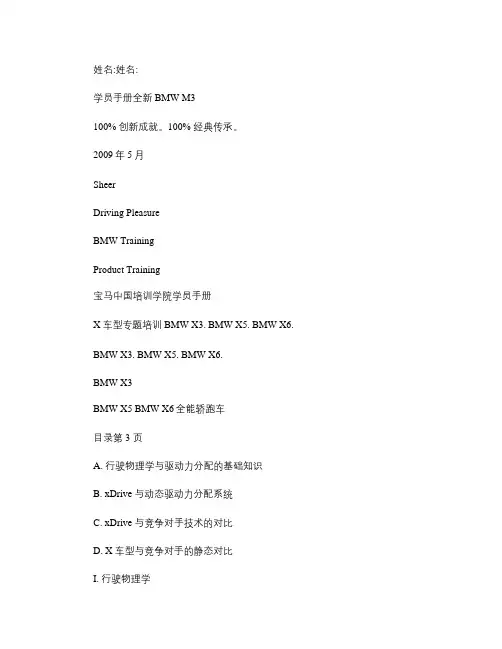
姓名:姓名:学员手册全新BMW M3100% 创新成就。
100% 经典传承。
2009年5 月SheerDriving PleasureBMW TrainingProduct Training宝马中国培训学院学员手册X 车型专题培训BMW X3. BMW X5. BMW X6. BMW X3. BMW X5. BMW X6.BMW X3BMW X5 BMW X6全能轿跑车目录第3 页A. 行驶物理学与驱动力分配的基础知识B. xDrive 与动态驱动力分配系统C. xDrive 与竞争对手技术的对比D. X 车型与竞争对手的静态对比I. 行驶物理学第4页II. 差速器与自动差速制动系统第10页BMW X3. BMW X5. BMW X6.I. xDrive第12页II.动态驱动力分配系统第16页I. 四轮驱动技术的历史第18页II.竞争对手的四轮驱动技术第21页I. BMW X3与竞争对手第24页II.BMW X5与竞争对手第28页目录备注:P a r t AA. 行驶物理学与驱动力分配的基础知识I. 行驶物理学讨论:为什么我们需要四轮驱动系统?BMW X 车型专题培训BMW X3. BMW X5. BMW X6.车辆在直线行驶时所受到的力____________________________________________________________________ ________________________________________________________________________________________横向力离心力纵向力分析持续力制动力重心车辆在弯道行驶时所受到的力____________________________________________________________________ ________________________________________________________________________ _____________________车身重量后轮负载前轮负载车辆在加速行驶时前后轮负载的变化________________________________________________________________________ ________________________________________________________________________ ____________横向力分析车辆在行驶过程中受到各个方向的力你的任务:设想在以下图示的状态下,车辆所受到的力的情况P a r t ABMW X 车型专题培训BMW X3. BMW X5. BMW X6.轮胎受力的情况卡姆圆(Circle of Kamm:代表着轮胎与其所接触的地面之间所决定的最大可传递力。
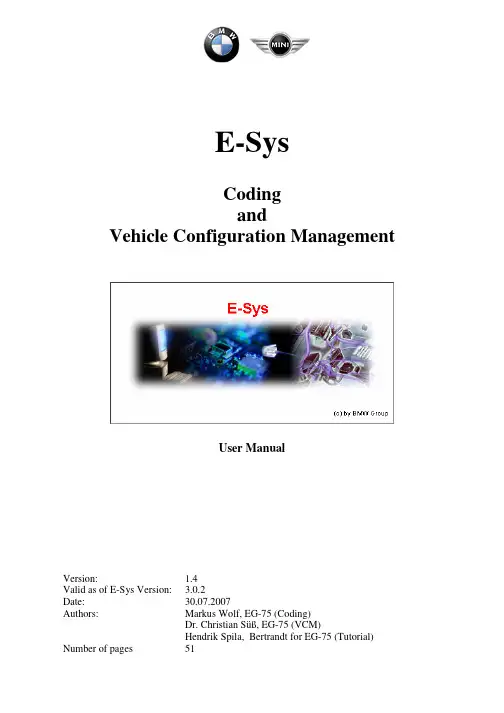
E-SysCodingandVehicle Configuration ManagementUser ManualVersion:1.4 Valid as of E-Sys Version:3.0.2 Date:30.07.2007 Authors:Markus Wolf, EG-75 (Coding) Dr. Christian Süß, EG-75 (VCM) Hendrik Spila, Bertrandt for EG-75 (Tutorial) Number of pages51Contents1 Overview (3)2 Expert Mode Coding (4)2.1 Graphical User Interface (GUI) (4)2.1.1 Vehicle data (5)2.1.2 Software variant table tree (7)2.1.3 SVT/SVKactual (8)2.1.4 KIS (8)2.1.5 Coding (9)2.1.6 Filter (9)2.2 Operation (9)2.2.1 Coding control unit/vehicle with vehicle order (9)2.2.2 Reading out control units (12)2.2.3 Coding control unit with FDL (13)2.2.4 Coding control unit to as-delivered condition (14)2.2.5 Read CPS (14)3 FDL Editor and CAF Viewer (16)3.1 GUI (16)3.2 Tree structure and tree contents (17)3.3 Operation (20)3.3.1 Editing function values (21)3.3.2 Editing coding values (22)4 Expert Mode Coding Verification (23)4.1 GUI (23)4.2 Verification of individual Coding Application Files (24)4.3 Verification by SVT/KIS (26)4.3.1 Verification by SVT (26)4.3.2 Verification by KIS (27)5 FA Editor (28)5.1 GUI (28)5.2 Operation (29)6 Expert Mode Vehicle Configuration Management (VCM) (31)6.1 GUI (31)6.2 Operation (34)6.2.1 File operations (34)6.2.2 VCM Master operations (35)6.2.3 VCM backup operations (36)7 List of abbreviations (38)A Coding Tutorial (39)A.1 Coding uncoded control unit without KIS support (39)A.2 Creating/editing and coding FDL (46)1 OverviewThis Manual describes the procedures for handling all tool components of E-Sys required for coding control units and entire vehicle electrical systems. These tool components include:•Expert Mode Coding for writing (coding), reading and modifying coding data of elec-tronic control units (ECUs) or vehicles.•Function Data List Editor (FDL Editor) for modifying coding data in control units •CAF Viewer for viewing Coding Application Files•Expert Mode Coding Verification for virtual verification (without control units) of Coding Application Files (CAFs) and for generating system variant tables from KIS •Vehicle Order Editor for creating and editing vehicle orders•Expert Mode Vehicle Configuration Management (VCM) for reading and writing ve-hicle configuration data.In addition, the Appendix contains a tutorial illustrating the individual steps required for cod-ing an uncoded control unit without KIS and using the FDL functionality.This document does not discuss the option of coding control units in pure TAL mode.E-Sys is used both to code control units developed in accordance with the Coding Specifica-tions SAP No. 10001491 or that use Standard Core 6.xx and to code carry over control units for the BN2000 environment in a BN2010 vehicle bus system.Note: It is advisable to use a colour printer for printed copies of this User Manual since vari-ous E-Sys displays are colour displays and are unsuitable for monochrome printouts.2 Expert Mode Coding2.1 Graphical User Interface (GUI)The expert GUI for coding is shown in the diagram below:The display area uses frames to allow the size of the displays for FA, FP and SVT to be matched individuallyExpert Mode Coding view contains the following components:•Vehicle data•SVT•SVT/SVKactual•KIS•Coding•FilterThe individual components are explained in further detail in the sections that follow.2.1.1 Vehicle dataThe Vehicle Data view consists of the Vehicle Order (Fahrzeugauftrag FA) and Vehicle Pro-file (FP) displays. Buttons allow you to read (Button read) vehicle orders from vehicles (more precisely VCM, see Chapter 6 Expert Mode Vehicle Configuration Management) or load (Button load) them from a file. E-Sys basically operates with FA lists that may contain sev-eral FAs. If an FA is read from the vehicle, a list is created containing only this FA. The FA is then displayed as a tree structure. The long VIN number (Vinlong) is always read from the VIN master (e.g. CAS/ZGW) or loaded from a file together with the FA. The illustration be-low shows the FA tree:If an FA list has been read or loaded, the user must initially select an FA and activate it for further actions. This is done using the context menu (right mouse button) or by double-clicking (FA entry is marked active). The vehicle profile is then determined for the activated FA and it is updated in the tree at the right. At the same time, the FA and the VIN are checked for validity. If the checksum of the VIN at the 9th position is incorrect, work on the selection cannot continue.Only one FA may be active at any one time. If an FA is activated and another FA entry from the list is activated, the currently activated FA is deactivated and the other FA is activated. The vehicle profile is calculated with the aid of an assignment table (FA2FP) that is a part of the PDX package. This also includes a check of the activated FA with respect to the FA2FP. If the FA contains elements (SAs or model codes etc.) that are not contained in the FA2FP, the selected FA is invalid and work cannot continue. In this case, the errored elements must be corrected with the FA Editor (see Chapter 5 FA Editor).The FP tree is shown below:The vehicle profile is extracted from the FA. It contains all optional extras and country spec packages (SALAs) and other information derived from model code, build level, supplemen-tary and trade organisation words (E words and HO words) and their readable meaning. This information is broken down within permanently predefined categories as criteria [see also Performance Specification VCM SAP No.10000908]. For example, this includes the follow-ing in the vehicle profile shown:Drive-side category with criterion LL for left-hand drive orEngine category with criterion N57D30 orFuel category with criterion DIESEL etc.The numerical values in the square brackets represent the machine-readable values of the ca-tegories and criteria.The vehicle profile is used when coding for evaluation of the Coding Application Files (CAFs). The function conditions in CAF files are based on Boolean logic operations of vehi-cle profile elements and, consequently, only indirectly on vehicle order elements.The save button can be used to save the displayed FA list as an XML file. The edit button opens the displayed FA list automatically in the FA Editor (see Chapter 5 FA Editor) for edit-ing. The vehicle profile can not be saved in this view (see Chapter 6 Expert Mode Vehicle Configuration Management (VCM) for saving).2.1.2 Software variant table treeThe software variant table tree (SVT tree) in this view does not contain all elements of an SVT but only the number logistics of vehicle electrical system users (SGBM IDs, SGBM = control unit description model), grouped on the basis of basic variant designations of the con-trol units. The diagnostic addresses can be found in hexadecimal notation after the basic vari-ant designators in square brackets. In addition, the root element of the tree shows the long VIN number of the activated vehicle order. The complete SVT can be displayed using the SVT Editor of E-Sys (not a part of this document). Both actual statuses of SGBM IDs of con-trol units and their target statuses can be shown merged in the tree. The differences are distin-guished by means of colour. Actual statuses are shown in font colour blue and target statuses are shown in font colour red. Font colour black identifies correspondence between target and actual configurations. The number of the basic variants in the relevant SVT is shown in brackets after the element ECUs (blue font colour SVTactual, red font colour SVTtarget).CAF identifiers (process class CAFD) are also marked with a symbol providing information on codability of a control unit in relation to the current configuration. CAFD entries with a green check mark can be used to code a control unit in the current configuration. Entries with a red cross cannot. The buttons in the Coding frame can also be used accordingly. Determin-ing this codability status for coding or read-out of a control unit is based on the following rules:1. A control unit can always be coded/read out if CAFD entries are present in the actualconfiguration (SVTactual), unless all non-coding process classes, i.e. all other classes apart from CAFD, are identical and the target configuration (SVTtarget) prescribes a different CAFD, e.g. with a higher version.2. A control unit can always be coded/read out if all non-coding process classes in targetand actual configuration are identical.3. A control unit can never be coded if a basic variant occurs only in the target configura-tion (control unit not fitted).4. A control unit cannot be coded if at least one non-coding process class has differencesin target and actual configuration and if there is no CAFD entry in the actual configu-ration. In this case, the control unit must first be set to the required software build by flash-programming.One other special feature of the SVT view in the Coding Expert GUI is fitting function data lists (FDLs) beneath CAFD elements. FDLs contain the interpreted, read-out coding data of a control unit in machine-readable form (see also Chapter 2.2.3 Coding control unit with FDL).FDLs can be fitted in the SVT tree in two ways:•Read-out of a control unit FDL is fitted automatically by E-Sys (see also Chapter2.2.2 Reading out control units)•Using the context menu New FDL on a CAFD entry and selecting an existing FDL using the File dialog box2.1.3 SVT/SVKactualActual configurations can be read from control units or loaded from a file in section SVT/SVKist(SVT/SVKactual). If a Vehicle Configuration Management (VCM) is available, the read (VCM) button can be used to read the entire SVT of a vehicle from its VCM. Identi-fication of individual control units is performed with read (ECU). In this case, E-Sys sends functional request read_SVK. The button load can be used to load an SVTactual from a file. The result is displayed in the SVT tree in all cases (in blue font colour unless an SVTtarget was already present). The edit button can be used to edit the SVTactual with the SVT Editor, and save can be used to save the SVTactual to a file.2.1.4 KISTarget configurations for control units or control unit networks (vehicle) can be calculated on the basis of the vehicle order (FA) and a target integration step or can be loaded from a file in section KIS. The result is shown in the SVT tree in both cases (in font colour red unless an SVTactual was already present). The edit button can be used to edit the SVTtarget with the SVT Editor, and save can be used to save the SVTtarget to a file.Alternatively, there is the option of determining the CAF for individual software units of a basic variant without specifying an integration step directly using the detect CAF for SWE function. This function can be applied to SWFL entries or basic variants in the SVT tree.Note: All KIS functions can be used only if a KIS knowledge base is available. The KIS knowledge base is installed only on PDX import of an integration step container.2.1.5 CodingThe buttons in the Coding frame are described in 2.2 Operation.2.1.6 FilterThe filter can be used to filter the SVT tree by process classes of the SGBM. For example, only entries with coding data process class CAFD can be displayed. Button SVT Reset deletes all contents of the SVT tree.2.2 OperationExpert Mode Coding basically offers many options for coding control units or entire vehicle electrical systems. The GUI offers major flexibility depending on application (control unit development or vehicle commissioning etc.) but also poses risks if operated incorrectly.2.2.1 Coding control unit/vehicle with vehicle orderIn order to code a control unit by vehicle order, it is initially necessary to load a valid vehicle order, activate it (see Chapter 2.1.1 Vehicle data) and establish a link to the central gateway of a vehicle (or test bench) or to a control unit (e.g. via CAN). Since the buttons for coding can be applied only to contents in the SVT tree, the SVT tree must be populated in the next step. There are several options for populating the SVT tree:1.Read SVTactual from connected control units functionally (button read (ECU)) or VCM(button read (VCM))orload SVTactual from file: This method is suitable only for test purposes and should nor-mally not be applied.If the connected control unit is already coded (CAFD entry present in SVTactual), it can be coded again with the CAF specified in the SVTactual (but, for instance, with a differ-ent vehicle order).2.Determine SVTtarget from KIS with button Calculate specifying a target integration Step(possible only if an integration step container with a KIS knowledge base has been im-ported)orload SVTtarget from file (button load). This is possible only if the required SVTtarget has been created beforehand with the SVT Editor.ordetect CAF for SWE via the KIS function. For this purpose, an SVTactual must be read or loaded. The assigned CAFs can be determined by marking the basic variant or individual SVT tree contents of process class SWFL by pressing button detect CAF for SWE. The in-formation is displayed as a selection tree in a separate window, ordered on the basis of software units SWFL and integration Steps:In the example, SWFL 0000000A_004_000_023 is assigned CAFD0000000F_004_000_006 at integration Step F001_08_09_315. No other SWFLs are as-signed a CAF.The selection is imported to the SVT tree as SVTtarget entry by marking the required CAFD entry and confirming with OK.If both SVTactual and SVTtarget have been determined, E-Sys displays both SVTs in the SVT view merged:In the case shown, only the CAF from the SVTtarget (red entry) can be used to code the con-trol unit (green check mark). The control unit is now coded by marking the CAFD entry and then clicking on button Code (or with Code in the context menu). E-Sys then automatically generates the required transaction list (TAL) and initiates processing of this list.A status report on success of the action is displayed at the end of the coding operation:The report is generated separately for each basic variant. Green font colour shows that the coding operation was successful and red font colour shows that the coding operation was er-rored. In the example, basic variant EVALBOARD at address 7E was coded successfully with cafd-0000006e-001-004-000.Error:The illustration below shows that the control unit can be coded only with the actual version of the CAF in accordance with the rules from Chapter 2.1.2 Software variant table tree. If the target version is to be coded, the control unit must first be programmed with the target soft-ware build (SWFL_0000009B_003_000_005).Coding of individual control units, control unit networks or in the total vehicle is controlled via marking in the SVT view. The actions triggered with button Code relate to • a marked CAFD entry• a single control unit (i.e. also all CAFs for this control unit) if a basic variant is mark-ed•all marked basic variants (and automatically their assigned CAFs) in the case of multi-selection•the total combination shown in the SVT if level ECUs or SVT is markedParallel TAL execution and stopping of TAL execution in the event of an error:If switch Parallel TAL-execution has been set when coding at level ECUs (total coding-related content of the SVT tree) or in the case of multi-selected basic variants, coding of all selected control units is performed in parallel.Switch Stop TAL on Error allows you to force an abort of TAL processing after the first error. Otherwise, errors that occur during the sequence are not displayed in the report until the end of TAL processing.2.2.2 Reading out control unitsButton Read coding data can be used to read out coding data from control units. As with the Code functionality, multiple selection of control units to be read out is possible here as well.•Selection of individual CAFD entriesControl unit is read out with the selected CAF•Selections at Basic Variants levelControl units are read out with all CADs listed below the selected basic variants •Selection at ECU or SVT levelAll control units with valid CAFD entries with green check mark in the SVT view are read out.The precondition for read-out of control units, as is also the case with coding, is that the CAFs required in accordance with the SVT view be present in the file system.The result of read-out operations is a net-coded data file (NCD) and a function data list file (FDL) per CAF. After read-out, both files are saved automatically to the file system. The FDLs are also appended in the SVT view as sub-elements of the related CAFD entries in font colour orange.The FDL generated can then be opened in the FDL Editor and edited using the context menu Edit FDL (see Chapter 3 FDL Editor)2.2.2.1Net coding dataThe NCD file with the net coding data read out is saved to E-Sys data directory ..\CAF. The file name of an NCD file corresponds to the name of the CAF used for read-out of a control unit, but with file extension ncd (e.g. CAFD_0005638F_003_025.001.ncd). The net coding data is written to the file in Motorola S-Record format, e.g.:S00A0000FF000000010401F0S206300000663E25S208300100ACE80F0F14S20C30210005FF00000001040198S22430220000000020D62448E9626B1CD69C941DF7470ED8A011063F88DF0ACCAD693 3FFA5EES224302220C62ADCC6C7AB18801BC853AABD3D9B94152DEF5495CA0A76C0C9A5C 08D2601AC12S2243022403F5B71E2B3356EE9BFA5D77C7F4CAA93E04A94C379200D60DF59DC736 A76C6E9C1S224302260D037FD2F4A0699F61530A6EEEF59C297EDD0E6347F4DDF82B36568C1692 8CE04F5S2083022802BB83841C9S503000EEENote: A detailed description of the S-Record can be found, for instance, athttp://www.amelek.gda.pl/avr/uisp/srecord.htm2.2.2.2Function data listAn FDL’s structure and content correspond to those of a CAF, but extended with the net cod-ing data read out from the control unit and interpretation thereof in function-value and coding-value pairs. The FDL is saved to E-Sys data directory ..\FDL. The file name of an FDL file corresponds to the name of the CAF used for read-out of a control unit, but with file extension fdl (e.g. CAFD_0005638F_003_025.001.fdl).2.2.3 Coding control unit with FDLIn Expert Mode Coding, E-Sys offers the option of changing and coding individual control unit functions in targeted manner. This is done with the aid of an FDL. A personal Developer Soft Token (EST) and the related PIN that you can apply for from the Automotive Security Backup Center (ASBC) (see also Tutorial) are required for running this function. The EST file must be specified under Options Settings EST.EST is available for the following roles:Role DescriptionBASIC Is required in order to open CAFs with read access with the Caf Editor ADVANCED Is required in order to allow coding with FDLs in E-SysEXPERT Is required in order to edit CAFs with the Caf EditorIn order to be able to code a control unit with an FDL, it must initially be created. This is done either by read-out of the control unit (see Chapter 2.2.2 Reading out control units) or using the context menu in the SVT view with the New FDL function with an existing FDL file. Both procedures can be applied only to individual CAFD entries in the SVT view.The FDL is displayed as a sub-element of the relevant CAFD entry in font colour orange after the action has been executed.The FDL can be opened and edited in the FDL Editor using the context menu edit FDL (see Chapter 3 FDL Editor and CAF Viewer).In order to code a control unit with FDL, mark the FDL entry beneath the CAFD entry in the SVT view and use the code FDL button to trigger the action. If this function has been called for the first time after E-Sys is launched, you are prompted to enter your personal PIN.When coding a control unit with FDL, only coding data described in the FDL under the ele-ments Ausgelesen/Werte (Read-out/Values) are written (see Chapter 3 FDL Editor and CAF Viewer).Notes: A vehicle order with valid VIN number must be loaded and activated in order to allow you to write a valid coding check stamp for the code FDL function. The vehicle order itself is not used for coding in this case.Coding of a control unit with FDL works only if the valid CAF on which the FDL is based is found in the E-Sys data path (identical SGBM ID and versions).2.2.4 Coding control unit to as-delivered conditionThe function for coding a control unit to as-delivered condition is primarily used in verifica-tion for control unit coding. A control unit is coded with this function independently of the vehicle order to the as-delivered values specified in the CAF. Since the SGBM ID of the CAF used is also set to the as-delivered condition (CAFD_FF…), read-out of the SVK supplies process classes CAFD with as-delivered values (see illustration) after successfully running this function.Function Code Default Values can be applied only to individual CAFD entries in the SVT tree.Note: The CPS is not set to as-delivered condition (0xFF) when this function is run.2.2.5 Read CPSThe coding proof stamp (CPS) serves the purpose of documentation of coding operations on codable control units. The CPS value corresponds to the last seven digits of the VIN of the vehicle order used to code a control unit and is written automatically to a control unit at the end of each coding operation.Function read CPS reads the CPS from control units. The SVT tree must be populated and at least one control unit in it must be marked at Basic Variants level for this:The result of the read-out operation is displayed as ASCII string (e.g. [RH09567]) behind the diagnostic address of the basic variant in square brackets.Alternatively, this function can also be applied to a total vehicle electrical system. For this purpose, mark level ECU in the SVT tree and then trigger the CPS determination process with button read CPS. Only control units having the SGBM process class CAFD for coding in the SVT tree are read out.If all CPSs have been read out, the user can check whether all codable control units have been coded to match the vehicle in which they are fitted as well. An automatic check for identical CPSs is not supported by E-Sys.3 FDL Editor and CAF ViewerBoth Coding Application Files and function data lists are XML files and are based on the same XML schema. An FDL is the result of a read-out operation of coding data of a control unit and always corresponds to the CAF that was used to read out the coding data but ex-tended with the values read out and their interpretation in the logical coding data layout.FDL Editor and CAF Viewer differ only in respect of the content of the tree view (FDL has additional sub-branches with coded values read out) and are described together under a gen-eral heading at this point.3.1 GUIThe FDL Editor is used to edit coding data of control units without reference to a vehicle or-der. The CAF Viewer is used to view CAF files. Both modules can be found in the module bar at the left beneath Editors and viewers. The view of the FDL Editor or CAF Viewer is shown in the illustration below.FDL Editor and CAF Viewer have the following controls and display elements: •File Name text field and button for opening an FDL or a CAF from the file system with the File dialog box•Text field and button for searching for codable function names in an FDL or CAF •Filter unit for controlling display of FDL/CAF contents•Tree view for editing or displaying the contents of FDLs or CAFs3.2 Tree structure and tree contentsThe contents of CAFs or FDLs are shown in a tree structure as follows: CAF [ECU name]HeaderAllgemein (general)Ersteller (originator)Kommentar (comment)Datum (date)EcuNameSpeicherlayout (memory layout)Allgemeiner Anlieferzustand (general as-delivered condition)NCD-Sig-BlockBN2000CodingJobList VersionCAF-IdentifikatorPKIDMVSVPVFahrzeugprofil-Info (vehicle profile information)Baureihenverbund (main series)PKIDMVSVPVDaten [Layout: Byte] (data)Data-Identifier Datagroup datagroup name, lenght of datagroup (bytes)Aktivbedingung (Activation condition)main series condition; descriptionFunktionen (functions)Function nameKommentar (comment)Speicher-Info (storage info)Start (start)Ende (end)Größe (size)Maske (mask)Anlieferungswerte (as-delivered value)function valueKommentar (comment)Bedingung (condition)X-PathWerte (values)Prüfschritt-ID (test step ID) (optional)Ausgelesen (read out) (FDL only)interpreted parameterWerte (read values)Prüfschritt-ID (test step ID) (optional)The following definitions apply to the structure of CAFs and FDLs:•Codable function: the term Codable Function means a control unit function that, if changed by coding, influences the behaviour of the control unit.•Function value: a codable function has one or more Function Values precisely one of which is assigned to it by coding. This assignment can be made by selecting a Func-tion Value from a set of possible Function Values in accordance with a coding condi-tion or by calculating the Function Value with a calculation job (e.g. active, not_active etc.).•Coding value: each function value is represented in the control unit by a Coding Value. This may be an individual numeric expression or a set of numeric expressions that are actually written to a control unit (e.g. 0xFF, 0x10 etc.)Description of the tree elements:•Header/generalo Originator: name of the originator of the CAFo Comment: free comment on the CAFo Date: creation date of the CAFo EcuName: name of the control unit for which this CAF is destined.o Memory layout: memory organisation of the coding description (currently only BYTE)o General as-delivered condition: general coding value of codable functions in uncoded state (as-delivered condition). Is used by E-Sys for application “Codeas-delivered condition” if no specific as-delivered state value is specified forthe corresponding codable functionso NCD Sig. Block: data identifier with which the signature of the net coding data is transferred to control unito BN2000: attribute specifying whether the CAF applies to a BN2000 control unit (value = true) or to a BN2010 control unit (value = false)o CodingJobList Version: version for creation of the CodingJobList for calcu-lated coding values of a codable function, taken as a basis for creation of theCAF•Header/CAF identifiero PK: process class for coding data (CAFD)o ID: SGBM ID of the CAFo MV: main version of the CAFo SV: secondary version of the CAFo PV: patch version of the CAF•Header/vehicle profile informationo Main series of the FA2FP mapping tablePK: process class of the FA2FP mapping table (FAFP)ID: SGBM ID of the FA2FP used to create the CAFMV: main version of the FA2FPSV: secondary version of the FA2FPPV: patch version of the FA2FP•Datao Data identifier of the data group with which the coding data of this data group is transferred to the control unito Active condition, main series: contains a Boolean expression indicating whether the data group for a main series is to be transferred to the control unitor not. The expression may be vehicle profile-dependent or job-dependent o Functions: bracket element around all codable functions of a data groupo Function: designation of the codable functiono Comment: comment on the codable functiono Storage information: information on the position of the codable function in the memory layoutStart: byte number of the start of the codable function in a data groupEnd: byte number of the end of the codable function in a data groupSize: describes the ratio of memory mapping of a codable function to a memory unit (1 byte). This may either be less than, greater than thememory unit or precisely one memory unit (less than unit, greater thanunit, equal to unit)Mask: describes position and size of the codable function in a memory unito As-delivered values: this describes the specific coding values of a codable function used by E-Sys for functionality “Code as-delivered condition”.o Function value: designation of a function value of a codable functionComment: free comment on a function valueCondition: description of the dependences of the function value on the vehicle profile•X-Path: Boolean expression from vehicle profile elements in X-Path notationCoding values: summary of the numerical (hexadecimal) values that a codable function for the function value may assume.Test step ID: reference ID for the function checklist, electrical system.o Read out: element for accommodating the coding values of the codable func-tion read out (only in the case of FDL).Interpreted function value: name of the function value determined on the basis of the coding value read out for a codable function value (as-sumes value UNKNOWN if no correspondence is found between cod-ing values in CAF and coding values read out from the control unit).Read coding values: the numeric coding values actually read out from the control unitTest step ID: reference ID for the function checklist, electrical system (as above)。
